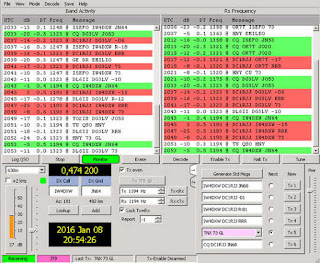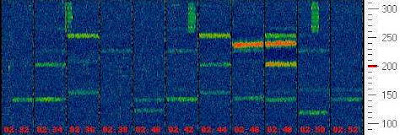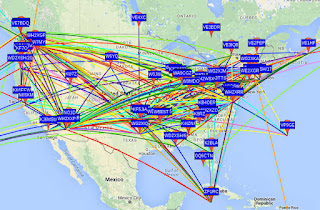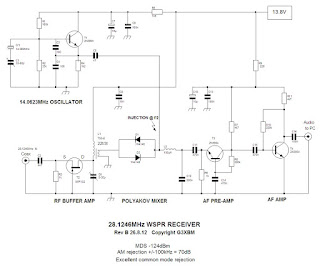Posts Tagged ‘WSPR’
 Making Weak Signal QSO’s On 630m
Making Weak Signal QSO’s On 630m

As much as I love CW and try and promote its use on 630m, one cannot deny the growing interest and use of the WSPR mode on our newest ham band.
Its ability to dig deep into the noise and successfully decode signals as weak as -30db makes it an attractive method of watching the night-to-night and hour-to-hour propagation magic.
One only needs to check the number of stations logged into the WSPRnet Activity-page, uploading 630m spots each night ... a typical evening will see 60-80 calls listed.
The main problem with WSPR is that it's a one-way, beacon-only mode and it's not possible to utilize it for a valid two-way contact. It's nice to know that station 'A' is able to hear station 'B', and vice-versa, but the only way for both stations to know this is for them to both be monitoring the internet uploads ... if both stations were able to confirm their respective receptions all via radio, then a two-way contact could be claimed. Thankfully, there is another mode that solves this dilemma, without internet intervention and that's JT9.
JT9, developed by K1JT, is a spin off from his JT65 weak signal QSO-mode software developed for EME. JT9 has been tailored for the noisier HF and MF bands and is apparently, about 2db more sensitive than JT65. In the past, I have made several single-yagi EME contacts on 2m using JT65, with many of these QSO's being in the -27 to -29 db range. This would suggest that 630m JT9 contacts could be made at signal levels as weak as -30db!
A recent "630m Activity Weekend" in Europe turned out be a "630m JT9 QSO Party" with dozens of Europeans working each other throughout the event using this weak signal mode with great success. It looks very much as if JT9 may now be the go-to mode for two-way work on 630m when, as is often the case, signals can be easily seen on a visual waterfall display, but are too weak to be heard on CW.
 |
| DC1RJJ's 630m JT9 action courtesy: KB5NJD |
On this side of the Atlantic, recent JT9 contacts have been made between several of the U.S. experimental stations. WH2XCR in Hawaii (K9FD/KH6) and WG2XIQ in Texas (KB5NJD) worked on Dec 9th, while WH2XGP (W7IUV), WG2XSV (W0YSE/7) and others have been exploiting the power of JT9 to work around the country.
Such has been the case for me recently, with the arrival of VE3OT on 630m. Since beginning his nightly slow speed CW, QRSS6 beaconing, his signals have been easily visible here every night but only strong enough to hear aurally, on two occasions. It is likely that we could work each other fairly routinely on JT9 but will need to wait for very good conditions to work on CW.
The good thing about modes such as WSPR and JT9 is that they can be used without the need for linear amplifiers in the PA ... class D or E amplifiers, fairly universal in the LF/MF world, can be employed. The most popular route at present seems to be via a homebrew transverter that will allow the use of the station's main HF transceiver (using the tone-generating JT9 / WSPR software) to generate the required 630m RF.
I've been looking for a new radio workbench project to catch my interest and building a 630m transmitting converter is beginning to look more attractive, now that we have another DX target in VE3 land ... of course, if and when the U.S.A. gets the band, there will be an entire new crew of stations spread across the continent to keep the transverter busy!
 The 1st Annual Midwinter 630m Activity Weekend
The 1st Annual Midwinter 630m Activity Weekend

Following late fall's very successful 630m Activity / CW Crossband Weekend in November, several enquiries were soon received asking "when's the next one?" I'm happy to announce that the 'next one' will be held on the first weekend of February and will follow a similar format.
Here is the formal press release describing the event published in the ARRL News:
*****************************************
US and Canadian radio amateurs and experimenters will join forces in February for the first Midwinter 630 Meter Activity Weekend. The event will get under way on February 6 at 0000 UTC (Friday, February 5, in US time zones) and run through 2359 UTC on February 7.
“This event is being undertaken because of the new and quickly growing interest in present 630 meter activities, both in the US and Canada,” said ARRL 600 Meter Experimental Group (WD2XSH) Experiment Coordinator Fritz Raab, W1FR. “Much of the interest is in response to the strong likelihood of US amateurs receiving access to the band in the near future, while Canadian hams are eager to learn more about the present level of Amateur Radio activity on their newest ham band.” The activity weekend comes on the heels of a special event operation over the November 13-14 weekend that included participation by US and Canadian radio amateurs.and the Maritime Radio Historical Society (MRHS).
Raab said the two activity nights will offer interested amateurs in both countries an opportunity to experience the 630 meter band and, through cross-band activity with Canadian amateurs, to take part in activity in the MF spectrum. “Our hope is to see this activity become an annual operating event, to be held very winter on the 630 meter band,” Raab said. “For those who may be building for future 630 meter operation, this event will provide an opportunity to test your ‘receive’ capabilities on MF.”
Operation will be from 472 kHz to 479kHz in various modes. The two-way crossband work will be undertaken by several Canadian stations, all on CW. Canadians will operate on a schedule and listen for callers on specific QSX frequencies in the US ham allocations.
Time: 2130Z - 0130Z both Friday night (Feb 5 - 6Z) / Saturday night (Feb 6 - 7Z) plus QRSS3 / 12 WPM Beacon from 0130 – 1000Z
TX Frequency: 477.7 kHz
RX (QSX) Frequency: 3562 kHz
Station: VE7SL (Steve) CN88 Mayne Island, B.C.
Time: 0200Z - 0700Z both Friday night (Feb 6Z) / Saturday night (Feb 7Z)
TX Frequency: 473.0 kHz
RX (QSX) Frequency: 3566 / 7066 kHz
Station: VE7BDQ (John) CN89 Delta, B.C.
Time: 0330Z - 0700Z both Friday night (Feb 6Z) / Saturday night (Feb 7Z)
TX Frequency: 474.0 kHz
RX (QSX) Frequency: 3555 kHz
Station: VA7MM (Mark) CN89 Coquitlam, B.C.
Time: 0500Z - 0700Z Friday night (Feb 6Z)
0400Z - 0800Z Saturday night (Feb 7Z)
TX Frequency: 475.0 kHz
RX (QSX) Frequency: 1801 kHz / 3574 kHz / 7062 kHz
Time: 0300Z - 0700Z both Friday night (Feb 6Z) / Saturday night (Feb 7Z)
TX Frequency: 476.5 kHz
RX (QSX) Frequency: 1836 kHz / 3558 kHz / 7031 kHz
Time: 0000Z - 0400Z both Friday night (Feb 6Z) / Saturday night (Feb 7Z)
TX Frequency: 477.0 kHz
RX (QSX) Frequency: 3563 kHz / 7058 kHz
“The success of this event largely depends upon the participation of as many amateurs as possible,” Raab said. “We hope that you can find a few hours to participate in this unique midwinter event.” Submit reception reports via e-mail to the respective operators or via the ARRL 600 Meter Experiment website.
*************************************
Hopefully you will be able to participate in the crossband activity by being able to listen on 630m and then able to switch over to HF to transmit. This could involve the use of a separate receiver / transmitter or can often be easily implemented via your transceiver's 'A/B' switch.
No antenna for receiving on 630m? Surprisingly good results can often be had by using a low band wire antenna such as a dipole or inverted-L for listening on 630m ... the antenna does not necessarily need to be resonant. In fact, often times, a non-resonant receiving antenna can provide a better overall S/N ratio than one which is resonant, as these often gather more noise along with signals.
You may want to experiment before hand by listening to many of the numerous U.S. experimental stations operating nightly, mostly in the WSPR mode, between 475.6 and 475.8kHz. Most operators provide a CW identifier following their WSPR transmission but a better way to decode these signals is by installing the latest WSPR software, WSJT-X (freeware), at K1JT's website here. The software works extremely well and is easy to install and get working. If you set the software to 'upload spots', you can share your nightly catches with dozens of other listeners throughout the continent on the WSPRnet website.
 |
| courtesy: KB5NJD's 630m Daily Blog |
 Using WSPR for some band analysis
Using WSPR for some band analysis
| My wet noodle on 40m WSPR on Dec 30 2200 UTC |
| 30m results at 2100 UTC Dec 30th |
| 17m from 1500-1550 UTC Dec 31 |
| 20m from 1600-1700 UTC Dec 31 |
 630m WSPR
630m WSPR
 |
| courtesy: http://wsprnet.org/ |
Happy Thanksgiving to those of you in the U.S.A.
It seems that the 630m WSPR digital crowd is growing quickly, with more new stations showing up every evening on the web's WSPRnet activity page. Most nights see activity from 80 or more stations, either transmitting or listening in WSPR mode on 630m!
WSPR is the 'Weak Signal Propagation Reporter' beacon-only mode being used by many of the stations presently transmitting on 630m, especially the U.S. experimental stations.
Those with the WSPR software (freeware and easily installed) usually have the program automatically upload their spots (stations being heard) to the WSPRnet page so that the transmitting stations are able to see where their signals are being heard. It also becomes quickly apparent, when examining the various spots, just how good or bad propagation might be at any given time.
 |
| WSPR Waterfall Displaying Detected Signals |
If you choose, you can also see your spotted stations in a Map mode, as shown at the top. This map shows the stations that I was hearing last night on 630m.
Along with the call and grid locator of the station being heard, the WSPR software also indicates several other bits of information, including the signal-to-noise ratio as heard at your location. Shown below is the decoded output from several stations following the two-minute transmission period.
| 06:58 | WH2XXP | 0.475662 | -13 | 0 | DM33 | 5 | VE7SL | CN88iu | 1909 | |
| 06:58 | WG2XXM | 0.475709 | -6 | 0 | EM15lj | 5 | VE7SL | CN88iu | 2610 | |
| 06:58 | WG2XKA | 0.475723 | -9 | 0 | FN33lq | 1 | VE7SL | CN88iu | 3833 |
Note the SNR reports ... usually, signals stronger than around -14dB will be just detectable by ear with anything in the + range being pretty strong.
Shown below are the Tuesday night reports of local station, VE7CNF, and indicates the extensive area over which his WSPR beacon was reported. Toby is running a modest 5W eirp station from a suburban-sized lot. Analyzing the reports, it is apparent that many of these stations rose to audible signal levels at various times throughout the evening and would have probably been workable on normal CW mode ... even from the 'burbs!
 |
| courtesy: http://wsprnet.org/ |
There are probably many of you already listening to WSPR signals on HF and have yet to venture down to 630m to see what can be heard. The improved propagation conditions of late make this an ideal time to have a peek at 630m and see what you can spot.
Your low-band wire antennas can often hear surprisingly well below the broadcast band and you may be surprised at what WSPR can detect. Use the USB mode with your receiver set to 474.200 kHz and, if possible, upload your 630m MF spots to the WSPRnet. You can also follow up-to-the-minute activity on the 2200m/630m ON4KST Chat page which is always interesting.
 630m Heating Up
630m Heating Up

In spite of the sun's nasty and continual huffing and puffing, conditions on 630m continue to surprise many of the nightly diehards. It seems clear, that for the time being, the digital WSPR mode is the one chosen by the majority of operators. I suspect that this will change to a more proportionate mix of both CW and digital, as more Canadians get on the band but more particularly, when U.S. amateurs get permanent access to 630m as a ham band. At present, it's mostly listeners reporting beacons, demonstrating the propagational capabilities to be found at the bottom of the broadcast band.
Last night saw over 80 stations worldwide, either listening or transmitting on 630m, with the majority of them in the 'listening mode' only.
 |
| courtesy: http://njdtechnologies.net/ |
It was particularly nice to see locals, VE7BDQ and VE7CNF being heard in the Cayman Islands and Hawaii, respectively ... both suburban backyard operations. The previous morning saw the experimental station run by Larry, W7IUV in Washington state, being heard in Japan by JA1NQI ... a first from the lower 48 into Japan.
Things over in Europe have also been heating-up and the nightly reports read more like a roster of 20m action. FR5ZX on Reunion Island in the Indian Ocean has been reporting many of the Europeans, making things more interesting for the dedicated in that part of the world. All of the reports were on the WSPR mode.
John (KB5NJD / WG2XIQ) in Texas, continues to post his amazingly-detailed nightly updates of 630m action. If you want to know what's been happening both here and in the rest of the world, his daily updates will keep you in the loop ... but be warned, as you will likely find yourself heading for 630m yourself to get in on the nightly activity. In addition, his blog contains a goldmine of information for those wanting to get started with building a 630m MF station. To really keep tabs of real-time happenings, the ON4KST MF chat page is the place to be.
Next weekend, the 630m CW crossband activity will take place, with 5 different Canadian CW stations CQing on 630m CW and listening for callers on various HF frequencies on 80 and 40m. I will have the details up here again shortly, but please give a listen for us on 630m as well as a call on HF, next Friday or Saturday (or both!) nights ... the more the merrier, and tell your friends too!
 WSPRing on 30M
WSPRing on 30M
 |
| 30m WSPRing |
 Simple 28MHz WSPR (or PSK31) RX
Simple 28MHz WSPR (or PSK31) RX
Facebook is throwing up memories from 3 years ago and one of these was a schematic for my WSPR RX for 10m, using low cost 14.060MHz crystals with a Polyakov mixer (injection at half signal frequency) The circuit worked well and could also be used for PSK31. Essentially this is a direct conversion receiver, but it mattered not. Even if you bought all parts new it is very inexpensive. 3 years later I would replace the 2 diodes by Schottky ones as these are now low cost and need less injection than the silicon ones shown.













